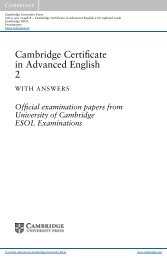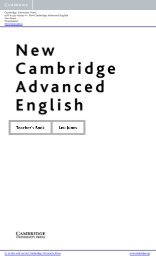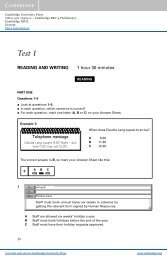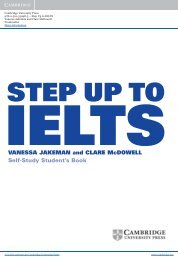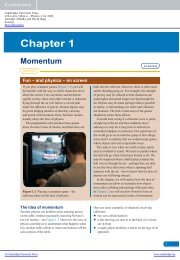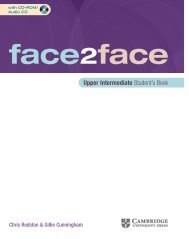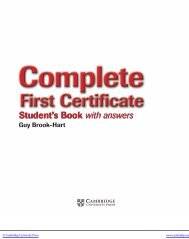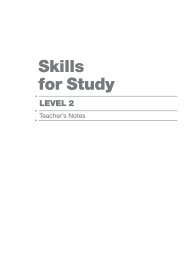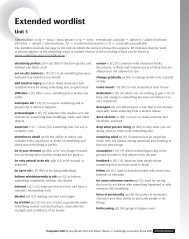Test 1 - Assets - Cambridge University Press
Test 1 - Assets - Cambridge University Press
Test 1 - Assets - Cambridge University Press
Create successful ePaper yourself
Turn your PDF publications into a flip-book with our unique Google optimized e-Paper software.
<strong>Cambridge</strong> <strong>University</strong> <strong>Press</strong>978-0-521-17380-3 – <strong>Cambridge</strong> IELTS 8<strong>Cambridge</strong> ESOLExcerptMore informationListeningQuestions 3–10Complete the form below.Write NO MORE THAN TWO WORDS AND/OR A NUMBER for each answer.Summer music festivalBooking formNAME:ADDRESS:George O’Neill3 ........................, WestseaPOSTCODE: 4 ........................TELEPHONE: 5 ........................Date Event Price per ticket No. of tickets5 June Instrumental group– Guitarrini£7.50 217 June Singer (priceincludes6 ........................ inthe garden)£6 222 June 7 ........................(Anna Ventura)£7.00 123 June Spanish Dance &Guitar Concert8 £ ........................ 9 .......................NB Children / Students / Senior Citizens have 10 ........................ discount on alltickets.11© in this web service <strong>Cambridge</strong> <strong>University</strong> <strong>Press</strong> www.cambridge.org
<strong>Cambridge</strong> <strong>University</strong> <strong>Press</strong>978-0-521-17380-3 – <strong>Cambridge</strong> IELTS 8<strong>Cambridge</strong> ESOLExcerptMore information<strong>Test</strong> 1SECTION 2 Questions 11–20Questions 11–15Complete the sentences below.Write NO MORE THAN TWO WORDS AND/OR A NUMBER for each answer.The Dinosaur Museum11 The museum closes at ........................ p.m. on Mondays.12 The museum is not open on ......................... .13 School groups are met by tour guides in the ......................... .14 The whole visit takes 90 minutes, including ......................... minutes for theguided tour.15 There are ........................ behind the museum where students can have lunch.Questions 16–18Choose THREE letters, A–G.Which THREE things can students have with them in the museum?ABCDEFGfoodwatercamerasbooksbagspensworksheets12© in this web service <strong>Cambridge</strong> <strong>University</strong> <strong>Press</strong> www.cambridge.org
<strong>Cambridge</strong> <strong>University</strong> <strong>Press</strong>978-0-521-17380-3 – <strong>Cambridge</strong> IELTS 8<strong>Cambridge</strong> ESOLExcerptMore informationListeningQuestions 19 and 20Choose TWO letters, A–E.Which TWO activities can students do after the tour at present?A build model dinosaursB watch fi lmsC draw dinosaursD fi nd dinosaur eggsE play computer games13© in this web service <strong>Cambridge</strong> <strong>University</strong> <strong>Press</strong> www.cambridge.org
<strong>Cambridge</strong> <strong>University</strong> <strong>Press</strong>978-0-521-17380-3 – <strong>Cambridge</strong> IELTS 8<strong>Cambridge</strong> ESOLExcerptMore information<strong>Test</strong> 1SECTION 3 Questions 21–30Questions 21–24Choose the correct letter, A, B or C.Field Trip Proposal21 The tutor thinks that Sandra’s proposalA should be re- ordered in some parts.B needs a contents page.C ought to include more information.22 The proposal would be easier to follow if SandraA inserted subheadings.B used more paragraphs.C shortened her sentences.23 What was the problem with the formatting on Sandra’s proposal?A Separate points were not clearly identified.B The headings were not always clear.C Page numbering was not used in an appropriate way.24 Sandra became interested in visiting the Navajo National Park throughA articles she read.B movies she saw as a child.C photographs she found on the internet.14© in this web service <strong>Cambridge</strong> <strong>University</strong> <strong>Press</strong> www.cambridge.org
<strong>Cambridge</strong> <strong>University</strong> <strong>Press</strong>978-0-521-17380-3 – <strong>Cambridge</strong> IELTS 8<strong>Cambridge</strong> ESOLExcerptMore informationListeningQuestions 25–27Choose THREE letters, A–G.Which THREE topics does Sandra agree to include in the proposal?A climate changeB fi eld trip activitiesC geographical featuresD impact of tourismE myths and legendsF plant and animal lifeG social historyQuestions 28–30Complete the sentences below.Write ONE WORD AND/OR A NUMBER for each answer.28 The tribal park covers ......................... hectares.29 Sandra suggests that they share the ........................ for transport.30 She says they could also explore the local ......................... .15© in this web service <strong>Cambridge</strong> <strong>University</strong> <strong>Press</strong> www.cambridge.org
<strong>Cambridge</strong> <strong>University</strong> <strong>Press</strong>978-0-521-17380-3 – <strong>Cambridge</strong> IELTS 8<strong>Cambridge</strong> ESOLExcerptMore information<strong>Test</strong> 1SECTION 4 Questions 31–40Complete the notes below.Write ONE WORD ONLY for each answer.GeographyStudying geography helps us to understand:• the effects of different processes on the 31 ......................... of the Earth• the dynamic between 32 .......................... and populationTwo main branches of study:• physical features• human lifestyles and their 33 .........................Specific study areas: biophysical, topographic, political, social, economic,historical and 34 ......................... geography, and also cartographyKey point: geography helps us to understand our surroundings and theassociated 35 ........................What do geographers do?• fi nd data – e.g. conduct censuses, collect information in the form of36 ........................ using computer and satellite technology• analyse data – identify 37 ........................, e.g. cause and effect16© in this web service <strong>Cambridge</strong> <strong>University</strong> <strong>Press</strong> www.cambridge.org
<strong>Cambridge</strong> <strong>University</strong> <strong>Press</strong>978-0-521-17380-3 – <strong>Cambridge</strong> IELTS 8<strong>Cambridge</strong> ESOLExcerptMore informationListening• publish fi ndings in form of:a) maps– easy to carry– can show physical features of large and small areas– BUT a two- dimensional map will always have some 38 .........................b) aerial photos– can show vegetation problems, 39 .......................... density, ocean fl oor etc.c) Landsat pictures sent to receiving stations– used for monitoring 40 ......................... conditions etc.17© in this web service <strong>Cambridge</strong> <strong>University</strong> <strong>Press</strong> www.cambridge.org
<strong>Cambridge</strong> <strong>University</strong> <strong>Press</strong>978-0-521-17380-3 – <strong>Cambridge</strong> IELTS 8<strong>Cambridge</strong> ESOLExcerptMore information<strong>Test</strong> 1READINGREADING PASSAGE 1You should spend about 20 minutes on Questions 1–13, which are based on ReadingPassage 1 below.Our conception of time depends on the way we measure itABC18According to archaeological evidence, at least 5,000 years ago, and long before the adventof the Roman Empire, the Babylonians began to measure time, introducing calendarsto co- ordinate communal activities, to plan the shipment of goods and, in particular, toregulate planting and harvesting. They based their calendars on three natural cycles: thesolar day, marked by the successive periods of light and darkness as the earth rotates onits axis; the lunar month, following the phases of the moon as it orbits the earth; andthe solar year, defined by the changing seasons that accompany our planet’s revolutionaround the sun.Before the invention of artificial light, the moon had greater social impact. And, for thoseliving near the equator in particular, its waxing and waning was more conspicuous thanthe passing of the seasons. Hence, the calendars that were developed at the lower latitudeswere influenced more by the lunar cycle than by the solar year. In more northern climes,however, where seasonal agriculture was practised, the solar year became more crucial. Asthe Roman Empire expanded northward, it organised its activity chart for the most partaround the solar year.Centuries before the Roman Empire, the Egyptians had formulated a municipal calendarhaving 12 months of 30 days, with five days added to approximate the solar year. Eachperiod of ten days was marked by the appearance of special groups of stars called decans.At the rise of the star Sirius just before sunrise, which occurred around the all- importantannual flooding of the Nile, 12 decans could be seen spanning the heavens. The cosmicsignificance the Egyptians placed in the 12 decans led them to develop a system in whicheach interval of darkness (and later, each interval of daylight) was divided into a dozenequal parts. These periods became known as temporal hours because their duration variedaccording to the changing length of days and nights with the passing of the seasons.Summer hours were long, winter ones short; only at the spring and autumn equinoxes© in this web service <strong>Cambridge</strong> <strong>University</strong> <strong>Press</strong> www.cambridge.org
<strong>Cambridge</strong> <strong>University</strong> <strong>Press</strong>978-0-521-17380-3 – <strong>Cambridge</strong> IELTS 8<strong>Cambridge</strong> ESOLExcerptMore informationReadingDEFwere the hours of daylight and darkness equal. Temporal hours, which were first adoptedby the Greeks and then the Romans, who disseminated them through Europe, remainedin use for more than 2,500 years.In order to track temporal hours during the day, inventors created sundials, which indicatetime by the length or direction of the sun’s shadow. The sundial’s counterpart, the waterclock, was designed to measure temporal hours at night. One of the first water clockswas a basin with a small hole near the bottom through which the water dripped out. Thefalling water level denoted the passing hour as it dipped below hour lines inscribed on theinner surface. Although these devices performed satisfactorily around the Mediterranean,they could not always be depended on in the cloudy and often freezing weather ofnorthern Europe.The advent of the mechanical clock meant that although it could be adjusted to maintaintemporal hours, it was naturally suited to keeping equal ones. With these, however, arosethe question of when to begin counting, and so, in the early 14th century, a number ofsystems evolved. The schemes that divided the day into 24 equal parts varied accordingto the start of the count: Italian hours began at sunset, Babylonian hours at sunrise,astronomical hours at midday and ‘great clock’ hours, used for some large public clocksin Germany, at midnight. Eventually these were superseded by ‘small clock’, or French,hours, which split the day into two 12- hour periods commencing at midnight.The earliest recorded weight - driven mechanical clock was built in 1283 in Bedfordshirein England. The revolutionary aspect of this new timekeeper was neither the descendingweight that provided its motive force nor the gear wheels (which had been around for atleast 1,300 years) that transferred the power; it was the part called the escapement. In theearly 1400s came the invention of the coiled spring or fusee which maintained constantforce to the gear wheels of the timekeeper despite the changing tension of its mainspring.By the 16th century, a pendulum clock had been devised, but the pendulum swung in alarge arc and thus was not very efficient.G To address this, a variation on the original escapement was invented in 1670, in England.It was called the anchor escapement, which was a lever- based device shaped like a ship’sanchor. The motion of a pendulum rocks this device so that it catches and then releaseseach tooth of the escape wheel, in turn allowing it to turn a precise amount. Unlikethe original form used in early pendulum clocks, the anchor escapement permitted thependulum to travel in a very small arc. Moreover, this invention allowed the use of a longpendulum which could beat once a second and thus led to the development of a new floorstandingcase design, which became known as the grandfather clock.HToday, highly accurate timekeeping instruments set the beat for most electronic devices.Nearly all computers contain a quartz- crystal clock to regulate their operation. Moreover,not only do time signals beamed down from Global Positioning System satellites calibratethe functions of precision navigation equipment, they do so as well for mobile phones,instant stock- trading systems and nationwide power- distribution grids. So integral havethese time- based technologies become to day- to- day existence that our dependency onthem is recognised only when they fail to work.19© in this web service <strong>Cambridge</strong> <strong>University</strong> <strong>Press</strong> www.cambridge.org



